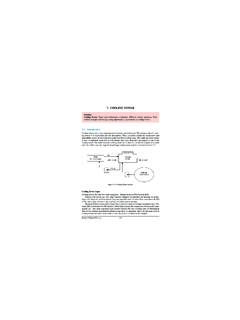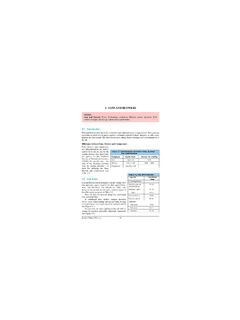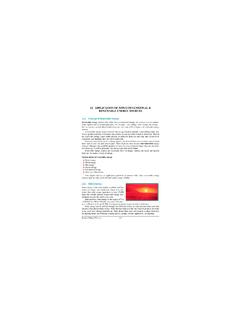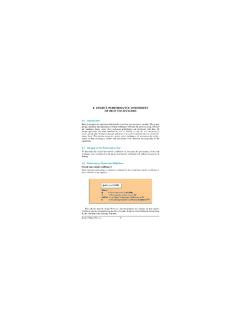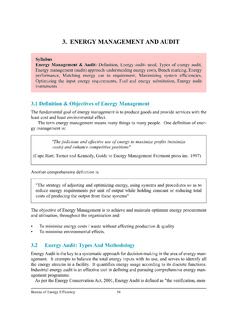Transcription of 2. BOILERS
1 2. BOILERS27 Bureau of Energy EfficiencySyllabusBoilers:Types, Combustion in BOILERS , Performances evaluation, Analysis of losses, Feedwater treatment, Blow down, Energy conservation IntroductionAboileris an enclosed vessel that provides a means for combustion heat to be transferred intowater until it becomes heated water or steam. The hot water or steam under pressure is thenusable for transferring the heat to a process. Water is a useful and cheap medium fortransferring heat to a process. When water is boiled into steam its volume increases about 1,600times, producing a force that is almost as explosive as gunpowder. This causes the boiler to beextremely dangerous equipment that must be treated with utmost process of heating a liquid until it reaches its gaseous state is called evaporation. Heatis transferred from one body to another by means of (1) radiation, which is the transfer of heatfrom a hot body to a cold body without a conveying medium, (2) convection, the transfer ofheat by a conveying medium, such as air or water and (3) conduction, transfer of heat by actualphysical contact, molecule to SpecificationThe heating surface is anypart of the boiler metalthat has hot gases of com-bustion on one side andwater on the other.
2 Anypart of the boiler metalthat actually contributesto making steam is heat-ing surface. The amountof heating surface of aboiler is expressed in square meters. The larger the heating surface a boiler has, the moreefficient it becomes. The quantity of the steam produced is indicated in tons of water evap-orated to steam per hour. Maximum continuous rating is the hourly evaporation that can bemaintained for 24 hours. F & A means the amount of steam generated from water at 100 Cto saturated steam at 100 C. Indian boiler RegulationThe Indian BOILERS Act was enacted to consolidate and amend the law relating to steam BOILERS Regulation (IBR) was created in exercise of the powers conferred by section 28& 29 of the Indian BOILERS boiler SpecificationBoiler Make & Year: XYZ & 2003 MCR(Maximum Continuous Rating) : 10 TPH (F & A 100 C)Rated Working Pressure: kg/cm2(g) Type of boiler : 3 Pass Fire tubeFuel Fired: Fuel 2/23/2005 11:21 AM Page 27 IBR Steam Boilersmeans any closed vessel exceeding liters in capacity and which isused expressively for generating steam under pressure and includes any mounting or otherfitting attached to such vessel, which is wholly, or partly under pressure when the steam is shutoff.
3 IBR Steam Pipemeans any pipe through which steam passes from a boiler to a prime moveror other user or both, if pressure at which steam passes through such pipes exceeds kg/cm2above atmospheric pressure or such pipe exceeds 254 mm in internal diameter and includes ineither case any connected fitting of a steam pipe. boiler Systems The boiler system comprises of: feed water system, steam system and fuel system. The feedwater systemprovides water to the boiler and regulates it automatically to meet the steamdemand. Various valves provide access for maintenance and repair. The steam systemcollectsand controls the steam produced in the boiler . Steam is directed through a piping system to thepoint of use. Throughout the system, steam pressure is regulated using valves and checked withsteam pressure gauges. The fuel systemincludes all equipment used to provide fuel to gener-ate the necessary heat. The equipment required in the fuel system depends on the type of fuelused in the system.
4 A typical boiler room schematic is shown in Figure Boilers28 Bureau of Energy EfficiencyFigure boiler Room SchematicThe water supplied to the boiler that is converted into steam is called feed water. The twosources of feed water are: (1) Condensateor condensed steam returned from the processes and(2) Makeup water(treated raw water) which must come from outside the boiler room and plantprocesses. For higher boiler efficiencies, the feed water is preheated by economizer, using thewaste heat in the flue 2/23/2005 11:21 AM Page 282. Boilers29 Bureau of Energy boiler Types and ClassificationsThere are virtually infinite numbers of boiler designs but generally they fit into one of two cat-egories: Fire tubeor fire in tube BOILERS ;contain long steel tubes throughwhich the hot gasses from afurnace pass and around which thewater to be converted to steam cir-culates. (Refer Figure ). Firetube BOILERS , typically have a lowerinitial cost, are more fuel efficientand easier to operate, but they arelimited generally to capacities of25 tons/hr and pressures of tubeor water in tube BOILERS in whichthe conditions are reversed with the water passingthrough the tubes and the hot gasses passing outsidethe tubes (see figure ).
5 These BOILERS can be ofsingle- or multiple-drum type. These BOILERS can bebuilt to any steam capacities and pressures, and havehigher efficiencies than fire tube boiler :The packaged boiler is socalled because it comes as a complete delivered to site, it requires only the steam,water pipe work, fuel supply and electricalconnections to be made for it to becomeoperational. Package BOILERS are generally ofshell type with fire tube design so as to achievehigh heat transfer rates by both radiation andconvection (Refer Figure ). Figure Fire Tube BoilerFigure Water Tube BoilerFigure Packaged 2/23/2005 11:21 AM Page 29 The features of package BOILERS are: Small combustion space and high heat release rate resulting in faster evaporation. Large number of small diameter tubes leading to good convective heat transfer. Forced or induced draft systems resulting in good combustion efficiency. Number of passes resulting in better overall heat transfer.
6 Higher thermal efficiency levels compared with other BOILERS are classified based on the number of passes the number of times the hotcombustion gases pass through the boiler . The combustion chamber is taken, as the first passafter which there may be one, two or three sets of fire-tubes. The most common boiler of thisclass is a three-pass unit with two sets of fire-tubes and with the exhaust gases exiting throughthe rear of the boiler . Stoker Fired boiler :Stokers are classified according to the method of feeding fuel to the furnace and by the type ofgrate. The main classifications are:1. Chain-grate or traveling-grate stoker2. Spreader stokerChain-Grate or Traveling-Grate Stoker BoilerCoal is fed onto one end of a moving steel chain grate. As grate moves along the length of thefurnace, the coal burns before dropping off at the end as ash. Some degree of skill is required,particularly when setting up the grate, air dampers and baffles, to ensure clean combustion leaving minimum of unburnt carbon in the Boilers30 Bureau of Energy EfficiencyFigure Chain Grate 2/23/2005 11:21 AM Page 302.
7 Boilers31 Bureau of Energy EfficiencyThe coal-feed hopper runs along the entire coal-feed end of the furnace. A coal grate is usedto control the rate at which coal is fed into the furnace, and to control the thickness of the coalbed and speed of the grate. Coal must be uniform in size, as large lumps will not burn out com-pletely by the time they reach the end of the grate. As the bed thickness decreases from coal-feed end to rear end, different amounts of air are required- more quantity at coal-feed end andless at rear end (see Figure ). Spreader Stoker BoilerSpreader stokers (see figure ) utilize a combination of suspension burning and grate coal is continually fed into the furnace above a burning bed of coal. The coal fines areburned in suspension; the larger particles fall to the grate, where they are burned in a thin, fast-burning coal bed. This method of firing provides good flexibility to meet load fluctuations,since ignition is almost instantaneous when firing rate is increased.
8 Hence, the spreader stokeris favored over other types of stokers in many industrial Spreader StokerPulverized Fuel BoilerMost coal-fired power station BOILERS use pulverized coal, and many of the larger industrialwater-tube BOILERS also use this pulverized fuel. This technology is well developed, and thereare thousands of units around the world, accounting for well over 90% of coal-fired capacity. The coal is ground (pulverised) to a fine powder, so that less than 2% is +300 micro metre( m) and 70-75% is below 75 microns, for a bituminous coal. It should be noted that too finea powder is wasteful of grinding mill power. On the other hand, too coarse a powder does notburn completely in the combustion chamber and results in higher unburnt losses. The pulverised coal is blown with part of the combustion air into the boiler plant through aseries of burner nozzles. Secondary and tertiary air may also be added. Combustion takes 2/23/2005 11:21 AM Page 31at temperatures from 1300-1700 C,depending largely on coal residence time in the boiler istypically 2 to 5 seconds, and the particles must be small enough forcomplete combustion to have takenplace during this system has many advantagessuch as ability to fire varying qualityof coal, quick responses to changes inload, use of high pre-heat air tempera-tures of the most popular systemsfor firing pulverized coal is the tangen-tial firing using four burners corner tocorner to create a fireball at the centerof the furnace (see Figure ).
9 FBC BoilerWhen an evenly distributed airor gas is passed upwardthrough a finely divided bed ofsolid particles such as sandsupported on a fine mesh, theparticles are undisturbed at lowvelocity. As air velocity isgradually increased, a stage isreached when the individualparticles are suspended in theair stream. Further, increase invelocity gives rise to bubbleformation, vigorous turbulenceand rapid mixing and the bed issaid to be fluidized. If the sand in a fluidizedstate is heated to the ignitiontemperature of the coal and thecoal is injected continuously into the bed, the coal will burnrapidly, and the bed attains auniform temperature due toeffective mixing. Proper air dis-tribution is vital for maintaining uniform fluidisation across the bed.). Ash is disposed by dryand wet ash disposal systems. 2. Boilers32 Bureau of Energy EfficiencyFigure Fluidised Bed CombustionFigure Tangential 2/23/2005 11:21 AM Page 32 Fluidised bed combustion has significant advantages over conventional firing systems andoffers multiple benefits namely fuel flexibility, reduced emission of noxious pollutants such asSOx and NOx, compact boiler design and higher combustion efficiency.
10 More details aboutFBC BOILERS are given in Chapter 6 on Fluidized Bed Performance Evaluation of BoilersThe performance parameters of boiler , like efficiency and evaporation ratio reduces with timedue to poor combustion, heat transfer surface fouling and poor operation and for a new boiler , reasons such as deteriorating fuel quality, water quality etc. can result inpoor boiler performance. boiler efficiency tests help us to find out the deviation of boiler efficiency from the best efficiency and target problem area for corrective action. boiler Efficiency Thermal efficiency of boiler is defined as the percentage of heat input that is effectively utilisedto generate steam. There are two methods of assessing boiler )The Direct Method:Where the energy gain of the working fluid (water and steam) iscompared with the energy content of the boiler )The Indirect Method:Where the efficiency is the difference between the losses and theenergy Direct MethodThis is also known as input-output method due to the fact that it needs only the useful output(steam) and the heat input ( fuel) for evaluating the efficiency.
